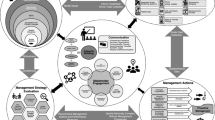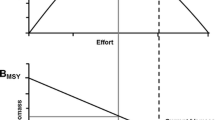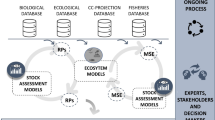Abstract
The term “data-limited fisheries” is a catch-all to generally describe situations lacking data to support a fully integrated stock assessment model. Data conditions range from data-void fisheries to those that reliably produce quantitative assessments. However, successful fishery assessment can also be limited by resources (e.g., time, money, capacity). The term “data-limited fisheries” is therefore too vague and incomplete to describe such wide-ranging conditions, and subsequent needs for management vary greatly according to each fishery’s context. Here, we acknowledge this relativity and identify a range of factors that can constrain the ability of analyses to inform management, by instead defining the state of being “data-limited” as a continuum along axes of data (e.g., type, quality, and quantity) and resources (e.g., time, funding, capacity). We introduce a tool (the DLMapper) to apply this approach and define where a fishery lies on this relativity spectrum of limitations (i.e. from no data and no resources to no constraints on data and resources). We also provide a ranking of guiding principles, as a function of the limiting conditions. This high-level guidance is meant to identify current actions to consider for overcoming issues associated with data and resource constraints given a specific “data-limited” condition. We apply this method to 20 different fisheries to demonstrate the approach. By more explicitly outlining the various conditions that create “data-limited situations” and linking these to broad guidance, we aim to contextualize and improve the communication of conditions, and identify effective opportunities to continue to develop and progress the science of “limited” stock assessment in support of fisheries management.

Source: Web of Science






Similar content being viewed by others
Data availability
The datasets generated during and/or analyzed during the current study are available at the following repository: https://github.com/shcaba/DL-Mapper
Notes
This tool can be accessed at https://connect.fisheries.noaa.gov/DLMapper/; tool development code can be found at https://github.com/shcaba/DL-Mapper.
References
Anderson CM, Krigbaum MJ, Arostegui MC, Feddern ML, Koehn JZ, Kuriyama PT, Morrisett C, Allen Akselrud CI, Davis MJ, Fiamengo C, Fuller A, Lee Q, McElroy KN, Pons M, Sanders J (2019) How commercial fishing effort is managed. Fish Fisheries 20:268–285. https://doi.org/10.1111/faf.12339
Bentley N (2015) Data and time poverty in fisheries estimation: potential approaches and solutions. ICES J Mar Sci 72:186–193
Berkström C, Papadopoulos M, Jiddawi NS, Nordlund LM (2019) Fishers’ local ecological knowledge (LEK) on connectivity and seascape management. Front Marine Sci. https://doi.org/10.3389/fmars.2019.00130
Blasco GD, Ferraro DM, Cottrell RS, Halpern BS, Froehlich HE (2020) Substantial gaps in the current fisheries data landscape. Front Marine Sci. https://doi.org/10.3389/fmars.2020.612831
Carruthers TR, Punt AE, Walters CJ, MacCall A, McAllister MK, Dick EJ, Cope J (2014) Evaluating methods for setting catch limits in data-limited fisheries. Fish Res 153:46–68
Carruthers TR, Kell LT, Butterworth DDS, Maunder MN, Geromont HF, Walters C, McAllister MK, Hillary R, Levontin P, Kitakado T, Davies CR (2016) Performance review of simple management procedures. ICES J Mar Sci 73:464–482. https://doi.org/10.1093/icesjms/fsv212
Chang W, Cheng J, Allaire JJ, Sievert C, Schloerke B, Xie Y, Allen J, McPherson J, Dipert A, Borges B (2021) Shiny: web application framework for R. R package version 1.7.1. https://CRAN.R-project.org/package=shiny
Chong L, Mildenberger TK, Rudd MB, Taylor MH, Cope JM, Branch TA, Wolff M, Stäbler M (2019) Performance evaluation of data-limited, length-based stock assessment methods. ICES J Mar Sci 7(77):97–108. https://doi.org/10.1093/icesjms/fsz212
Chrysafi A, Kuparinen A (2016) Assessing abundance of populations with limited data: lessons learned from data-poor fisheries stock assessment. Environ Rev 24:25–38. https://doi.org/10.1139/er-2015-0044
Costello C, Ovando D, Hilborn R, Gaines SD, Deschenes O, Lester SE (2012) Status and solutions for the world’s unassessed fisheries. Science 338:517–520
Day J (2019) Tiger Flathead (Neoplatycephalus richardsoni) stock assessment using data to 2018. pp 97 - 189 In Tuck, G.N. (Eds.) 2020. Stock assessment for the southern and eastern scalefish and shark fishery 2018 and 2019. Part 1, 2019. Australian Fisheries Management Authority and CSIRO Oceans and Atmosphere Hobart p. 353
Dowling NA, Smith DC, Knuckey I, Smith ADM, Domaschenz P, Patterson HM, Whitelaw W (2008) Developing harvest strategies for low-value and data-poor fisheries: case studies from three Australian fisheries. Fish Res 94:380–390
Dowling NA, Dichmont CM, Haddon M, Smith DC, Smith ADM, Sainsbury K (2015) Guidelines for developing formal harvest strategies for data-poor species and fisheries. Fish Res 171:130–140
Dowling NA, Dichmont CM, Haddon M, Smith DC, Smith ADM, Sainsbury K (2015) Empirical harvest strategies for data-poor fisheries: a review of the literature. Fish Res 171:141–153
Dowling NA, Smith A, Smith DC, Parma AM, Dichmont CM, Sainsbury K, Wilson JR, Dougherty DT, Cope JM (2019) Generic solutions for data-limited fishery assessments are not so simple. Fish Fisheries 20:174–188
Dowling NA, Wilson JR, Cope JM, Dougherty DT, Lomonico S, Revenga C, Parma AM (2023) The FishPath approach for sustainable fisheries management. Fish Fisheries. https://doi.org/10.1111/faf.12721
Eichenberg T, Shapson M (2004) The promise of Johannesburg: Fisheries and the world summit on sustainable development, Golden Gate U. L. Rev 34. https://digitalcommons.law.ggu.edu/ggulrev/vol34/iss3/6/
Emery T, Woodhams J, Moore A, Liggins G, Fairclough D (2021) Gemfish Rexea solandri. In: Piddocke T, Ashby C, Hartmann K, Hesp A, Hone P, Klemke J, Mayfield S, Roelofs A, Saunders T, Stewart J, Wise B, Woodhams J (eds) Status of Australian fish stocks reports 2020. Fisheries Research and Development Corporation, Canberra
Francis RICC, Shotton R (1997) “Risk” in fisheries management: a review. Can J Fish Aquat Sci 54:1699–1715. https://doi.org/10.1139/f97-100
Free CM, Jensen OP, Anderson SC, Gutierrez NL, Kleinser KM, Longo C, Minto C, Osio GC, Walsh JC (2020) Blood from a stone: performance of catch-only methods in estimating stock status. Fish Res. https://doi.org/10.1016/j.fishres.2019.105452
Garibaldi L, Caddy JF (2004) Depleted marine resources: an approach to quantification based on the FAO capture database. FAO Fisheries Circular. No. 1011. Rome, FAO. p. 32
Geromont H, Butterworth DS (2015) A review of assessment methods and the development of management procedures for data-poor fisheries. FAO Report. The Marine Resource Assessment and Management Group (MARAM), University of Cape Town, South Africa. pp. 219
Hilborn R, Ovando D (2014) Reflections on the success of traditional fisheries management. ICES J Mar Sci 71(5):1040–1046. https://doi.org/10.1093/icesjms/fsu034
Hilborn R, Amoroso RO, Anderson CM, Baum JK, Branch TA, Costello C, de Moor CL, Faraj A, Hively D, Jensen OP, Kurota H, Little LR, Mace P, McClanahan T, Melnychuk MC, Minto C, Osio GC, Parma AM, Pons M, Segurado S, Szuwalski CS, Wilson JR, Ye Y (2020) Effective fisheries management instrumental in improving fish stock status. Proc Nat Acad Sci 117:2218–2224. https://doi.org/10.1073/pnas.1909726116
Honey KI, Moxley JH, Fujita RM (2010) From rags to fishes: data-poor methods for fishery managers. Manag Data-Poor Fisheries: Case Studies, Models Solut 1:159–184
Hordyk AR, Huynh QC, Carruthers TR (2019) Misspecification in stock assessments: common uncertainties and asymmetric risks. Fish Fisheries 20:888–902. https://doi.org/10.1111/faf.12382
Johannes RE (1998) The case for data-less marine resource management: examples from tropical nearshore fin fisheries. Trends Ecol Evol 13:243–246
Legault CM, Wiedenmann J, Deroba JJ, Fay G, Miller TJ, Brooks EN, Bell RJ, Langan JA, Cournane JM, Jones AW, Muffley B (2023) Data-rich but model-resistant: an evaluation of data-limited methods to manage fisheries with failed age-based stock assessments. Can J Fish Aquat Sci. https://doi.org/10.1139/cjfas-2022-0045
Little R, Rowling K (2010) 2010 Update of the Eastern Gemfish (Rexa solandri) stock assessment. pp 97 - 113 In: Tuck, G.N. (Eds.) 2010. Stock assessment for the southern and eastern scalefish and shark fishery: 2010. Part 1, 2010. Australian Fisheries Management Authority and CSIRO Oceans and Atmosphere, Hobart. Pp. 374p
Liu OR, Thomas LR, Clemence M, Fujita R, Kritzer JP, McDonald G, Szuwalski C (2016) An evaluation of harvest control methods for fishery management. Rev Fish Sci Aqua 24:244–263. https://doi.org/10.1080/23308249.2016.1161002
Loneragan NR, Wiryawan B, Hordyk AR, Halim A, Proctor C, Satria C, Yulianto I (eds) (2021) Proceedings from workshops on management strategy evaluation of data-limited fisheries: towards sustainability - applying the method evaluation and risk assessment tool to seven Indonesian Fisheries. Western Australia, and IPB University, Indonesia, Murdoch University, p 185
Magnusson A, Punt AE, Hilborn R (2013) Measuring uncertainty in fisheries stock assessment: the delta method, bootstrap, and MCMC. Fish Fisheries 14:325–342. https://doi.org/10.1111/j.1467-2979.2012.00473.x
Maunder MN, Punt AE (2013) A review of integrated analysis in fisheries stock assessment. Fish Res 142:61–74. https://doi.org/10.1016/j.fishres.2012.07.025
McDonald G, Campbell SJ, Karr K, Clemence M, Granados-Dieseldorff P, Jakub R, Kartawijaya T, Mueller JC, Prihatinningsih P, Siegel K, Syaifudin Y (2018) An adaptive assessment and management toolkit for data-limited fisheries. Ocean Coastal Manag 152:100–119. https://doi.org/10.1016/j.ocecoaman.2017.11.015
McGarvey R, Matthews JM (2001) Incorporating numbers harvested in dynamic estimation of yearly recruitment: onshore wind in interannual variation of South Australian rock lobster (Jasus edwardsii). ICES J Mar Sci 58(5):1092–1099. https://doi.org/10.1006/jmsc.2001.1098
McGarvey R, Matthews JM, Prescott JH (1997) Estimating lobster recruitment and exploitation rate from landings by weight and numbers, and age-specific weights. Mar Fresh Res 48:1001–1008. https://doi.org/10.1071/MF97209
McGarvey R, Punt AE, Matthews JM (2005) Assessing the information content of catch-in-numbers: a simulation comparison of catch and effort data sets. In: Kruse GH, Gallucci VF, Hay DE, Perry RI, Peterman RM, Shirley TC, Spencer PD, Wilson B, Woodby D (eds) Fisheries assessment and management in data-limited situations. Alaska Sea Grant, University of Alaska Fairbanks, pp 635–657. https://doi.org/10.4027/famdis.2005.34
Methot RD, Wetzel CR (2013) Stock synthesis: a biological and statistical framework for fish stock assessment and fishery management. Fish Res 142:86–99. https://doi.org/10.1016/j.fishres.2012.10.012
Mildenberger TK, Berg CW, Kokkalis A, Hordyk AR, Wetzel C, Jacobsen NS, Punt AE, Nielsen JR (2022) Implementing the precautionary approach into fisheries management: biomass reference points and uncertainty buffers. Fish Fisheries 23:73–92. https://doi.org/10.1111/faf.12599
Molony BW, Newman SJ, Joll L, Lenanton RCJ, Wise BS (2011) Are Western Australian waters the least productive waters for finfish across two oceans? A review with a focus on finfish resources in the Kimberley region and North Coast Bioregion. J Royal Soci Western Australia 94:323–332
Mueter FJ, Megrey BA (2006) Using multi-species surplus production models to estimate ecosystem-level maximum sustainable yields. Fish. Res. 81:189–201. https://doi.org/10.1016/j.fishres.2006.07.010
Newman SJ, Brown JI, Fairclough DV, Wise BS, Bellchambers LM, Molony BW, Lenanton RCJ, Jackson G, Smith KA, Gaughan DJ, Fletcher WJ, McAuley RB, Wakefield CB (2018) A risk assessment and prioritisation approach to the selection of indicator species for the assessment of multi-species, multi-gear, multi-sector fishery resources. Marine Policy 88:11–22
Omori KL, Hoenig JM, Luehring MA, Baier-Lockhart K (2016) Effects of underestimating catch and effort on surplus production models. Fish Res 183:138–145
Ovando D, Free CM, Jensen OP, Hilborn R (2021) A history and evaluation of catch-only stock assessment models. Fish and Fisheries. https://doi.org/10.1111/faf.12637
Pacific Fishery Management Council (2020) Pacific Coast Groundfish Fishery Management Plan For the California, Oregon, and Washington Groundfish Fishery. 7700 NE Ambassador Place, Suite 101 Portland, OR 97220 https://www.pcouncil.org/documents/2016/08/pacific-coast-groundfish-fishery-management-plan.pdf/
Pantazi V, Mannini A, Vasilakopoulos P, Kapiris K, Megalofonou P, Kalogirou S (2020) That’s all I know: inferring the status of extremely data-limited stocks. Front Marine Sci. https://doi.org/10.3389/fmars.2020.583148
Pilling GM, Apostolaki P, Failler P, Floros C, Large PA, Morales-Nin B, Reglero P, Stergiou KI, Tsikliras AC (2008) Assessment and Management of data-poor fisheries. In: Payne A, Cotter J, Potter T (eds) Advances in Fisheries Science. Blackwell Publishing Ltd., Oxford, pp 280–305. https://doi.org/10.1002/9781444302653.ch12
Plagányi ÉE, Murphy N, Skewes T, Dutra LXC, Dowling N, Fischer M (2020) Development of a data-poor harvest strategy for a sea cucumber fishery. Fish Res 230:105635
Prince JD (2003) The barefoot ecologist goes fishing. Fish Fisheries 4:359–371
Prince J, Hordyk A (2019) What to do when you have almost nothing: a simple quantitative prescription for managing extremely data-poor fisheries. Fish Fisheries 20(2):224–238. https://doi.org/10.1111/faf.12335
Ralston S, Polovina JJ (1982) A multispecies analysis of the commercial deep-sea handline fishery in Hawaii. Fish Bull 80:435–448
Rudd MB, Cope JM, Wetzel CR, Hastie J (2021) Catch and length models in the stock synthesis framework: expanded application to data-moderate stocks. Frontiers Marine Sci 8:1119. https://doi.org/10.3389/fmars.2021.663554
Sjostrom AJC, Ciannelli L, Conway F, Wakefield WW (2021) Gathering local ecological knowledge to augment scientific and management understanding of a living coastal resource: the case of Oregon’s nearshore groundfish trawl fishery. Mar Pol 131:104617. https://doi.org/10.1016/j.marpol.2021.104617
Smith D, Punt A, Dowling N, Smith A, Tuck G, Knuckey I (2009) Reconciling approaches to the assessment and management of data-poor species and fisheries with Australia’s Harvest Strategy Policy. Marine Coastal Fisheries: Dynamics, Manag, Ecosyst Sci 1:244–254
Spielberg S (Director) (1975) Jaws [Film]. Zanuck/Brown Company
Tribuzio CA, Echave KB, Omori KL (2021) Assessment of the Other Rockfish stock complex in the Gulf of Alaska. In: Stock assessment and fishery evaluation report for the groundfish resources of the Gulf of Alaska, North Pacific Fishery Management Council, 605 W 4th Ave, Suite 306. Anchorage, AK 99501. pp. 53
Wetzel CR, Punt AE (2011) Model performance for the determination of appropriate harvest levels in the case of data-poor fisheries. Fish Res 110:342–355
Wetzel CR, Punt AE, Cope JM (2018) The effect of reduced data on the ability to monitor rebuilding of overfished fish stocks. Fish Bull 116:190–206. https://doi.org/10.7755/FB.116.2.8
Zimmermann F, Enberg K (2017) Can less be more? Effects of reduced frequency of surveys and stock assessments. ICES J Mar Sci 74:56–68. https://doi.org/10.1093/icesjms/fsw134
Acknowledgements
We are particularly grateful to Brent Wise for his role in initiating the World Fisheries Congress session on data poor fisheries and to all the conveners and organisers of that conference despite the ongoing global challenges. We very much thank the following scientists for providing us with information on data and resource constraints for our selected fishery examples; Daniel Johnson, Ashley Fowler, Steve Newman, David Fairclough, Matias Braccini, Anthony Hart. We thank all that attended and contributed to the data-limited session of the World Fisheries Congress, despite the challenges of juggling time zones via a remote meeting.
Author information
Authors and Affiliations
Contributions
JM. Cope was a co-lead developer of the paper concept, provided lead writing of the Introduction and Methods sections, produced several figures, edited the final version of the manuscript and developed the software application DLMapper. NA. Dowling, SA. Hesp, and KL. Omori were co-lead developers of the paper concept, providing lead writing of the results and discussion sections, produced figures and tables, provided major editing of the manuscript, and provided significant feedback on the DLMapper application. The remaining authors provided fishery examples to use in the paper and/or editorial assistance with the paper along with review of the DLMapper application.
Corresponding author
Ethics declarations
Conflict of Interest
The authors have no relevant financial or non-financial interests to disclose. The authors have no competing interests to declare that are relevant to the content of this article. All authors certify that they have no affiliations with or involvement in any organization or entity with any financial interest or non-financial interest in the subject matter or materials discussed in this manuscript. The authors have no financial or proprietary interests in any material discussed in this article.
Additional information
Publisher's Note
Springer Nature remains neutral with regard to jurisdictional claims in published maps and institutional affiliations.
Supplementary Information
Below is the link to the electronic supplementary material.
Rights and permissions
About this article
Cite this article
Cope, J.M., Dowling, N.A., Hesp, S.A. et al. The stock assessment theory of relativity: deconstructing the term “data-limited” fisheries into components and guiding principles to support the science of fisheries management. Rev Fish Biol Fisheries 33, 241–263 (2023). https://doi.org/10.1007/s11160-022-09748-1
Received:
Accepted:
Published:
Issue Date:
DOI: https://doi.org/10.1007/s11160-022-09748-1




